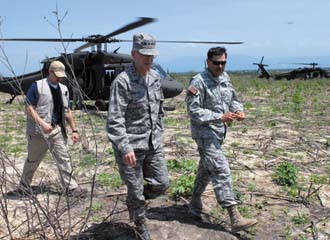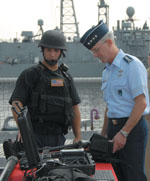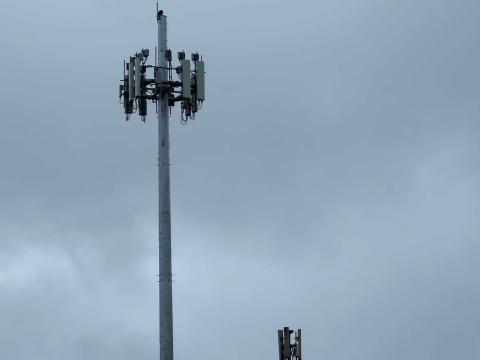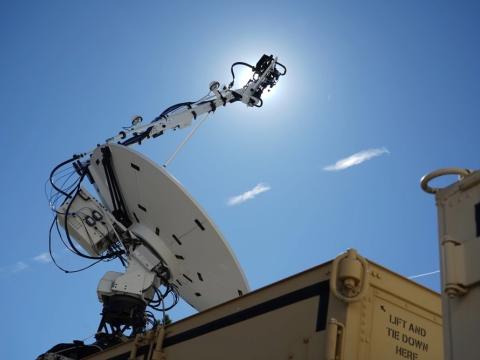 |
Gen. Douglas Fraser, USAF (c), commander of U.S. Southern Command (SOUTHCOM), and Maj. Gen. Simeon Trombitas, USA (r), former commander of Joint Task Force (JTF)-Haiti and current commander of U.S. Army South, make their way to the resettlement camp Corail Cesselesse after an aerial tour of the Port-au-Prince area. Gen. Fraser was on his sixth visit to the area and wished to see firsthand the progress made in relief efforts following an earthquake that caused massive damage to the island nation. |
National allies untangle a web spun of cash, weapons, illegal drugs.
The most prevalent perils facing the mainland United States may come not from the east or the west, but from the south, an area of the globe often overlooked in the talk about global security. Unlike other U.S. geographic combatant command theaters, the U.S. Southern Command area of responsibility has no wars and no major military-power threats. It does, however, encompass hundreds of billions of dollars worth of illicit trafficking every year. But those troubles are only part of the story. The command also serves as a model for the power of interagency collaboration and neighbor-to-neighbor support, as many countries in the region have been able to grow their democracy, reduce the size and influence of terrorist groups and offer aid to nations hit hard by natural disasters. Relationships and technology can hold the answers for bringing stability to an area that historically has been unsettled.
Though concerns about war and terrorist attacks make major headlines, far more common and oft-encountered threats facing U.S. citizens are drugs and gangs. A large portion of those problems have roots in the parts of the globe that Southern Command (SOUTHCOM) has the obligation to protect and serve. Because few of these problems require a direct military engagement, the command has become adroit at establishing strong ties with interagency and private partners.
Gen. Douglas Fraser, USAF, commander of SOUTHCOM, says his command sees Latin America and the Caribbean as a region important for U.S. security and for partnerships. “Some of the challenges we face are endemic problems—poverty, income inequality and corruption—which undermine the general security situation in the region and enable some of the illicit trafficking that goes on, which is really our primary concern,” the general states. “We work very closely with our partners in the region, and we have good military-to-military relations with almost every country in the region.”
The illicit trafficking activities include the smuggling of weapons, humans, exotic animals and especially drugs. Gen. Fraser says drugs are the biggest problem, “but the networks are there that support all these other avenues. Drugs come out of the region, but there are arms ... and bulk cash that move back in. It’s hard to separate one from the other.” The smuggling activity continues to grow as traffickers extend beyond U.S. markets to those in Europe and the Middle East. Combating the problem is traditionally not a military activity, so SOUTHCOM works with the U.S. State Department and the U.S. Agency for International Development on programs to help improve security throughout the region.
Because so little of what occurs in the command’s area of responsibility (AOR) involves kinetic military engagement, Gen. Fraser says his people rely on “smart power” where the focus is on staying engaged with partners, usually through training events. One caution he has for people thinking about the region is not to consider it a homogenous mass. Rather, it is an area of the world with 31 countries and 10 territories, each with unique characteristics.
Command personnel work with U.S. country and embassy teams in whatever nation they operate. Activities include medical readiness exercises that prepare U.S. forces to deploy and operate in austere conditions while providing medical benefits to indigent populations. Though SOUTHCOM trains across the spectrum with its partners, its major focus is to help nations meet their own security needs. That support entails efforts such as preparing the military to support law enforcement agencies and training for peacekeeping operations.
The relationships the command works so hard to build have paid big dividends. One of the most prominent success stories from the region is the improvement in the security situation in Colombia. Over the past 10 years, the United States has supported Colombia in its anti-drug, anti-terror efforts, pouring more than $5 billion into the country. “The Colombians have invested significantly more than that,” Gen. Fraser says. The results exhibit a good return on investment. Homicide rates are down 40 percent, terrorist attacks have dropped by more than 76 percent, and the country’s most powerful terrorist organization, the Revolutionary Armed Forces of Colombia, or FARC, has seen a dramatic decrease in its operations and popular support.
Even more telling is a shift in the issues critical to the voting population. “We see right now in the presidential election ongoing in Colombia that security is no longer at the top of the populace’s concern,” Gen. Fraser says. “That’s been a huge success on the part of Colombia with the support of the United States.”
 |
Gen. Fraser (r) speaks with a USS McInerney vessel, board, search and seizure team member during a tour of the ship. Gen. Fraser received tours and briefings about the McInerney, the MQ-8B Fire Scout unmanned aerial vehicle, the U.S. Naval Forces Southern Command (NAVSO) and U.S. Fourth Fleet during his first visit to his naval component command since becoming the SOUTHCOM commander. As the naval component command for SOUTHCOM, NAVSO is responsible for U.S. Navy activity throughout the SOUTHCOM area of focus, which encompasses the Caribbean, Central and South America, and surrounding waters. |
Partnership building also affects emergency response, a common activity in the SOUTHCOM AOR. In early to mid 2010, troops helped
Guatemala after it suffered floods as a result of a tropical storm and
Chile and
Haiti after massive earthquakes. In
Haiti, prior relationships came into play to aid response efforts. Lt. Gen. P.K. Keen,
USA, who served as the commander of Joint Task Force (JTF)-
Haiti from January through April, had trained in
Brazil when he was a captain with the man who turned out to be the U.N. mission commander to the response. “They had known one another for more than 20 years,” Gen. Fraser says. Gen. Keen now is the military deputy commander of SOUTHCOM.
A U.S. Marine battalion commander also caught up with an old friend when his unit operated side by side with Canadian forces and he worked with a former classmate. The partnerships even extend outside of the region, with support forces coming from nations such as Japan, South Korea, Italy and France. They have operated together for years and already understood how to coordinate their activities during the response. JTF-Haiti stood down on June 1, and SOUTHCOM resumed traditional security assistance activities. Maj. Gen. Simeon Trombitas, USA, commander of U.S. Army South, served as commander of the task force after Gen. Keen.
In addition to forming bonds between military members and between the military and other government agencies, SOUTHCOM personnel also work closely with private organizations. “In trying to gather information about the situation that was ongoing in Haiti, we reached out into what we call nontraditional intelligence channels—any place there was information,” Gen. Fraser explains. “NGOs [nongovernmental organizations] have a lot of information capabilities. Businesses have a lot of capabilities. Religious institutions have information. So it is pulling all those pieces together to help us understand what the situation is on the ground. We leveraged that.”
This intelligence gathering first was accomplished through communications tools such as e-mail, text and conference calls. Eventually, the exchange of data was moved to the All Partners Access Network where everyone involved had access to the breadth of information available. “It was trying to use every source of information we could find to bring together in a coherent location,” Gen. Fraser states. He adds, “We see that as an opportunity in the future to build upon our ability to gain knowledge especially [about] a disaster as quickly as we can so we can send the right capabilities there to support the needs.”
Gen. Fraser also has identified areas where the right technology still is lacking. He says private industry can step up to meet these challenges. “What we need is technology applied to provide some of our partner nations with the ability to conduct their own intelligence, surveillance and reconnaissance [ISR],” he states, adding that they require increased capacity of low-cost reliable capability. “And I’ll talk about it from a communications standpoint,” he continues, “that can also interoperate with high-end capabilities. Then we leverage the capabilities of everybody to support whatever crisis or need happens.”
Though the militaries in Latin America have different technology resources, Gen. Fraser does not view this as a major concern. “I don’t see it as a discrepancy in technology,” he explains. “I think that we need to recognize that here are differing capabilities and requirements for different armed forces. From my standpoint, as we look at partnership capacities, we need to have a tool set that allows us to empower and enable those armed forces to meet their own security needs.”
Understanding differences and limitations is a key to operating together. “I think technology can help us do that, but ... a lot of time from a technology standpoint—this is my view—we focus on the high-end stretch technologies end in pushing the conventional capabilities.”
What he would prefer are tools such as U.S. Air Force Liberty aircraft that can provide ISR to partner nations as well as light-lift aircraft that can provide mobility and capabilities to organizations that otherwise could not afford them. He also shares the need for radio communications and capabilities that are reliable, inexpensive and free from the need for a large supply infrastructure. SOUTHCOM already has a program called Enduring Friendship through which it provides partner navies with interceptor boats—go-fast types—that have communications and command and control suites to enable them to support U.S. efforts to counter illicit trafficking.
Other marks of the power of partnerships come from the maritime domain and from the Joint Interagency Task Force South, or JIATF-S, a component command subordinate to SOUTHCOM. The task force includes 17 different federal agencies and liaisons from 13 different countries involved primarily in the detection and monitoring of air and maritime illicit trafficking. “Last year they disrupted or detained about 226 metric tons of cocaine, about 25 percent of what we estimate is the total traffic,” Gen. Fraser explains. This effort forces criminals to work harder and to adjust their tactics. The battle to counter these illegal actions is hard-fought because illicit trafficking is a lucrative enterprise. By U.S. estimates, these activities generated $394 billion in profits last year.
With the maritime environment becoming more secure and certain countries cracking down harder on smugglers, these criminals are moving more traffic onto the isthmus of Central America. It is more difficult for law enforcement and partners to operate there than on the ocean, because actions must be pursued on a country-by-country basis. Central American nations are feeling the ill effects of that move. Gen. Fraser says the average homicide rate in Central America is 36 per 100,000 people, and in some places that jumps to 50 in every 100,000. In contrast, the U.S. homicide and non-negligent manslaughter rate is 5.4 per 100,000. Trafficking also is moving farther south into Peru, Brazil and Argentina with products eventually making their way through West Africa into Europe. “It’s an issue that will be with us for awhile,” Gen. Fraser says.
One of the countries hardest hit by drug wars recently is the United States’ neighbor to the south—Mexico. Violence in that country has escalated as drug smugglers and gangs compete. Though Mexico falls under U.S. Northern Command’s AOR, SOUTHCOM works closely with its fellow command to address the problem. “There is not a seam between our two COCOMs,” Gen. Fraser states. Also helping is Colombia, which is sharing the lessons it has learned fighting drug violence.
The proximity of Mexico to the United States drives home the importance of Latin America to U.S. citizens. “We don’t recognize how important the region is to us a lot of times,” Fraser states. “We have a large Hispanic population in the U.S.—45 million people. We’re the fifth largest Spanish-speaking country in the world ... We send $45 billion of remittances back to the region.” The United States also imports oil from its southern neighbors, especially Mexico and Venezuela. Yet, the general says, from a general-population standpoint, “We don’t traditionally focus to the south. We focus east and west.”
However, views of the region are shifting. Gen. Fraser says not only are other countries around the world looking at Latin America in new ways, but countries in the area are doing the same thing. “It’s a competitive environment down there as we work to engage our partners. They’re looking to all parts of the globe now to build their capacity and we just need to be part of that engagement.”
WEB RESOURCES
Gen. Douglas Fraser Biography: www.af.mil/information/bios/bio.asp?bioID=5456
U.S. Southern Command: www.southcom.mil
Joint Interagency Task Force South: www.jiatfs.southcom.mil
U.S. Agency for International Development: www.usaid.gov






Comments